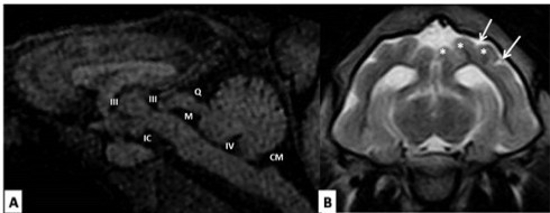Introduction
Hydrochoerus hydrochaeris belongs to the order Rodentia and it is considered the largest rodent. The cerebrospinal fluid is produced in the choroid plexus of each lateral ventricle and then this fluid flows into the subarachnoid space that surrounds the brain, the spinal cord, nerve roots, and the optic nerves. At certain sites, crevices of the brain surface establish subarachnoid space enlargements known as cistern.
Objectives
The aim of this partial study is to describe the meninges of the brain with emphasis on cisterns and sulcus in living capybara by means of MRI providing more detailed information of intracranial structures of this species, for research centers and clinics of wild animal veterinary medicine.
Methods
Eight adult capybaras were submitted to MRI examination using a 0.25 Tesla equipment (Vet-Grande; Esaote, Italy), under general anesthesia using face mask. Anatomical aspects of the cisterns and sulcus were evaluated by T1W, T2W and FLAIR sequences on the transverse, sagittal and dorsal planes.
Results
The major cisterns of the brain could be easily differentiated by MRI (Figure 1.A), observing prominence of the cerebellomedullary and quadrigeminal cisterns. The encephalic sulcus were well defined and could be used to delimit the cortical gyrus (Figure 1.B).
| Figure 1 | 
(A) T1-weighted mid-sagittal MRI showing the schema of the cisterns and III and IV ventricles and (B) T2-weighted transversal MRI showing the sulcus (arrows) and gyrus (asterisk). CM = cerebellomedullary cistern; IC = intercrural cistern; M = mesencephalic aqueduct; Q = quadrigeminal cistern. |
|
| |
Conclusions
Capybaras have brain sulcus and cisterns well defined by MRI when compared to the most animals of the Rodent order. However, the aspects are similar to domestic animals.